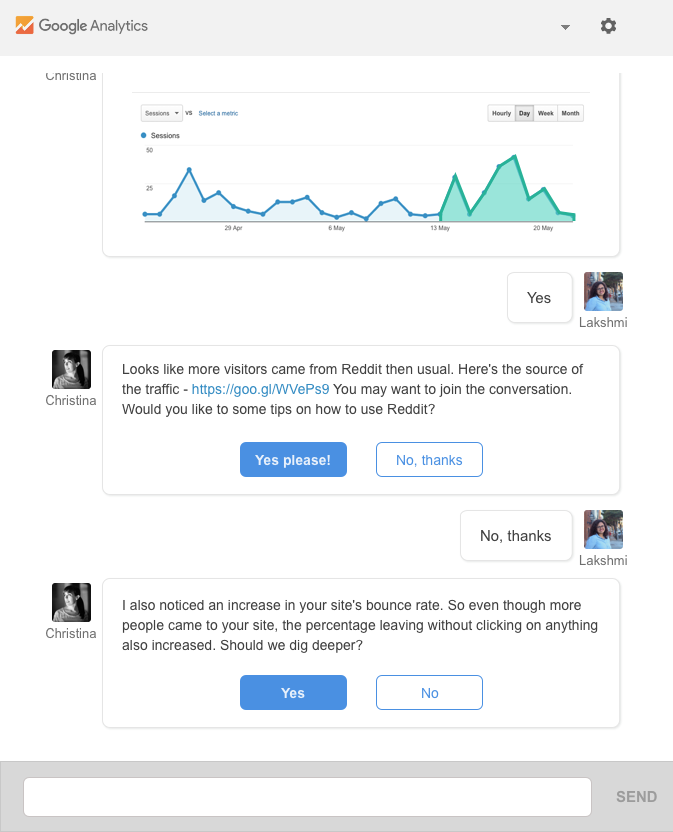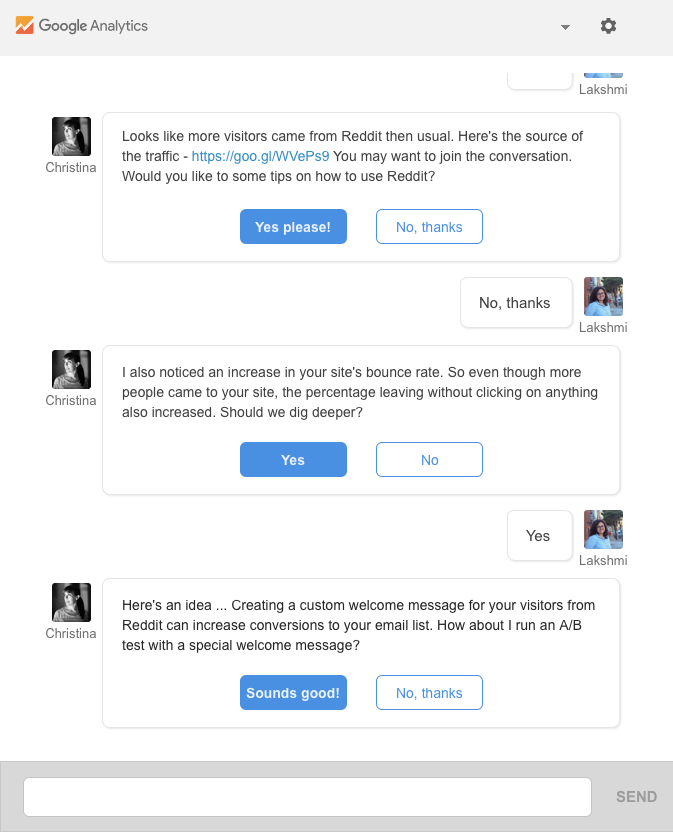This is the second part of the 2-series article about the reasons why conversations will reinvent software.
2. What do I do next? (Support decision making)
In the real world, when two friends have coffee together, one might raise a topic to gauge the other person’s interest in further discussion. Perhaps catching up on how the kids are doing, how’s business, or a bit of gossip—we test interest to see what’s worth talking about.
If the other party wants to talk about something else, it would be rude to stubbornly insist on only talking about one thing.
However, that’s exactly what today’s software does.
It keeps nagging us with topics we don’t care about because, unlike a good friend, it doesn’t care to learn.
A conversational interface, however, can do something no ordinary dashboard can do; it listens and learns. By noting the user’s response to the discrete piece of information presented, the software remembers whether the insight was valuable.
If the user continues the conversation about this information, the system learns the importance and raises similar concerns in the future. But if they don’t write back, great, that’s one less notification the app needs to send and one fewer interruption to the user’s day.
Unlike a traditional dashboard, the conversational interface gets better at its job of presenting relevant information the more it is used and therefore becomes a more powerful decision support tool. This concept is called “stored value” and is a key to building habit-forming products according to the Hook Model.

Furthermore, the conversational interface can learn from other users to improve the experience for everyone.
For example, when Christina points out the spike in traffic is coming from Reddit, the information she presents isn’t just a statement of fact, she surfaces options to consider.
To offer intelligent choices, Google could use the behaviors of other users to offer up the best next steps.

In this example, the assistant suggests a resource for learning how to use Reddit effectively, prompts the user to join the conversation there, and offers to help fix the site’s high bounce rate to increase the number of users who stick around.
Helping the user figure out what to do next is hugely valuable
The easier the next action is to do, the more likely the user is to do it. The conversational interface easily surfaces the next best actions, saving the user time from hunting and second-guessing what to do next.
By combining information from the user’s past conversations and other users’ actions, the new interface provides a better decision support tool to answer the question “What do I do next?”
3. How do I do it? (Facilitate action)
Finally, now that the software has elevated what’s important and given the user options to consider, it’s time to facilitate the actions the user wants to take.
Unfortunately, actually getting the task done with today’s software requires navigating a hodgepodge of solutions on disparate screens and sites. A conversational interface can eliminate all of that.
For instance, in the example below, when the user asks Christina for help with the site’s high bounce rate, she suggests creating a custom landing page that welcomes visitors from Reddit. Setting up such a page is child’s play for someone who has done it before but for a novice it can be more work than it’s worth.
Thankfully, a conversational interface can get the job done behind the scenes in any number of ways. The assistant can offer upgraded services, summon in-house expertise, or incorporate an outside vendor.
Instead of relying on the user to get up to speed on yet another software tool, the assistant turns to people or bots who already know what they are doing.
The point is, unlike today’s enterprise software that requires the user to figure out how to help themselves (a task most people just won’t do) a conversational assistant can do the work by taking the path of least resistance.

Here again, the conversational interface stores value every time a change is made to the site. With each page built or experiment run, the new Google Analytics learns more about the site owner’s goals and past results, making it easier to suggest improvements and making the service truly indispensable.
Die dashboard die!
Several workplace surveys have found we spend between 20 to 30 percent of our day looking for information.
Even small reductions in the amount of time and effort spent digging around clunky enterprise software would yield significant dividends.
While not ideal for every use case, there are many benefits the conversational interface has over the enterprise software status quo. Fundamentally, it is better at answering what’s important?, what do I do next?, and how do I do it?
By adopting this more novice-friendly interface, tomorrow’s software has the opportunity to cure the dashboard fatigue infecting the enterprise. It also promises to make solutions accessible to people who just don’t have the time to learn new tools.
The future of enterprise software won’t be about complicated dashboards and mind-numbing amounts of big data; it will be about well-designed interfaces that make work a pleasure.
Software should be like a good friend—ask and ye shall receive
What do you think? Will conversational interfaces kill the dashboard? What other software would be better with a CUI (conversational user interfaces)? Let me know in the comment section below!
For more business and entrepreneurship tips, check our entrepreneurship section and subscribe to our weekly newsletters.






